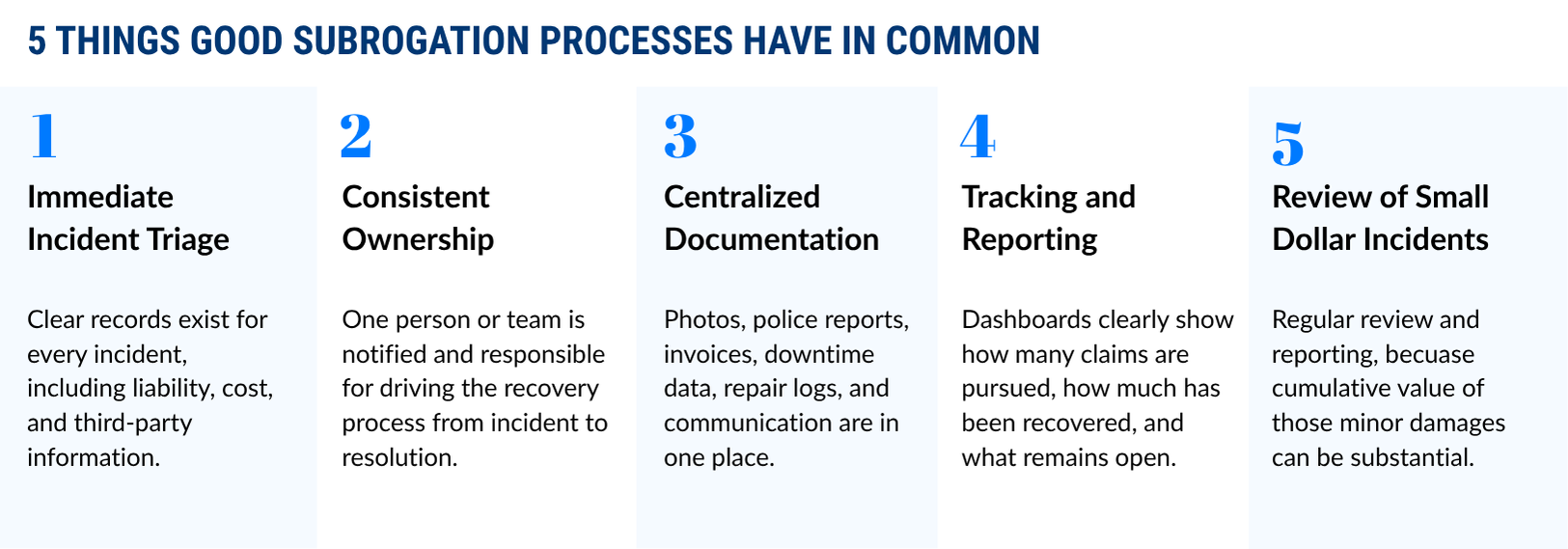Est. 4 min read
Every year, fleets quietly leave hundreds of thousands of dollars on the table. The culprit? Broken or inconsistent subrogation. For those who are unfamiliar, subrogation is the process of recovering costs from a third party responsible for an accident. For fleets, it’s how you get reimbursed for repairs, replacements, or downtime when another driver was at fault.
But subrogation isn’t just a legal formality. It’s a financial opportunity that too many fleets overlook. Without a clear system to flag, document, and follow through on those small recoverable incidents, dollars slip away unnoticed. And over time, those silent leaks add up to significant losses.
The Cost of Inaction
Most fleets don’t have a clear view of how much money they actually recover from at-fault parties, and that lack of visibility hides a big gap between what’s possible and what’s typical. The numbers tell the story.
According to the National Association of Insurance Commissioners (NAIC), when salvage and subrogation are managed effectively, auto physical damage claims recover about 20% of net claims paid. Yet for commercial auto collisions, average recovery sits at just 12.7%—meaning nearly 90% of losses go unrecovered. These are costs fleets end up absorbing, not because they must, but because the process to reclaim them is often inconsistent or broken.
.png)
Industry experts estimate that 15% of all claim files are closed without any subrogation pursuit whatsoever. Combine that with low recovery percentages, and it’s clear: a large portion of accident spend is left sitting on the table every year.
Why is the process often broken or insufficient?
A $2,000 mirror replacement or $3,500 trailer scrape often doesn't seem to be worth chasing. Fleets are juggling compounding pressure to improve their profit margins, keep up with evolving mandates and regulations, and protect against increasing nuclear verdicts. But when a fleet sees dozens of small claims go untouched each year, they stack up to significant losses.
Example
For example, a fleet spending $1 million a year on accident-related repairs would typically recover about $127,000 at that 12.7% rate. But by tightening the process and reaching a realistic 30%, that same fleet could reclaim $300,000. That’s $173,000 added to their budget without additional headcount or workload.
What the Industry Gets Right and Wrong
The financial impact of these missed recoveries compounds quickly when you look at overall repair spend across the industry. The American Transportation Research Institute (ATRI) reports that repair and maintenance costs reached between $0.1076 and $0.202 per mile in 2023. For a truck running 100,000 miles per year, that’s as much as $20,000 annually per truck—and a meaningful percentage of that is collision-related.
But too many fleets rely on disconnected spreadsheets, shared drives, siloed documents, and slow internal follow-ups to manage recoveries. Without a defined system, no-fault incidents go unpursued, and repair dollars are written off instead of reclaimed.
What A Strong Process Looks Like
Fleets that consistently recover 30% or more don’t have secret teams; they have systems. Those systems share a few simple policies and procedures.

How to Close the Gap
The right systems make all the difference.
Fleets that automate as much of the subrogation process as possible—while maintaining visibility into every claim, large or small—recover more and lose less. When everything lives in one connected system, teams can document incidents, assign ownership automatically, and track resolution without chasing updates or juggling spreadsheets.
That’s exactly what Idelic’s SafeTrac is designed to do. It centralizes accidents, incidents, and claims into a single workflow and gives leadership a clear view of what’s been recovered, what’s still open, and what’s quietly slipping through the cracks, turning subrogation into an ongoing, measurable source of savings.
Better Subrogation = Better Insurance Outcomes
The benefits don’t stop at recovered dollars. Beyond immediate savings, a disciplined subrogation process signals to insurers that your fleet actively manages losses. Over time, that can lead to lower premiums, stronger underwriting positions, and more favorable renewals.
Insurers view fleets with strong recovery programs as lower overall risk profiles, because every dollar recovered represents proactive claims management and reduced total loss exposure. When combined with clear documentation and a reduction in unrecovered claim dollars, these practices can drive measurable improvements in loss ratios and help stabilize or even reduce insurance rates over multiple policy periods.
In short, effective subrogation doesn’t just pay you back, it pays forward.
Conclusion
Fleets are leaving hundreds of thousands of dollars on the table each year, often because recoverable accident costs slip through the cracks. The truth is, reclaiming that money doesn’t require a major overhaul or a full legal team. It comes down to a few small process changes, consistent documentation, and having a repeatable system in place.
By tightening up subrogation practices and centralizing accidents and claims management, fleets can recover lost dollars with minimal effort to pad existing budgets and build a case for lower insurance rates. Every dollar you recover is one you can reinvest in what matters most: your drivers, your equipment, and your safety culture.
Ready to see how easy it can be to close the gap? Learn more about SafeTrac.




